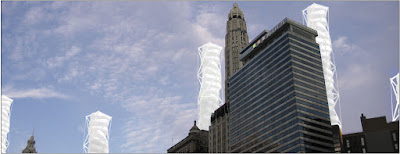click images for larger view
When, at the turn of the 20th century, Louis Sullivan talked about an "organic" architecture, it was largely a poetic conceit.Despite their rich ornament, their greenest feature was probably the windows that opened and closed, which, like the central atriums of the large "donut" office buildings of the same time, allowed for natural lighting and ventilation.
As modern architecture involved at mid-century, even that feature was thrown in the trash bin, replaced by sealed glass boxes with huge floorplates and glazed facades that leaked heat in the winter and sucked up solar gain in the summer, all compensated for by pumping in btu-guzzling air conditioning and forced air in that lost era of "cheap" energy.
Now, energy is anything but cheap, and architects strive towards "zero energy" structures that produce as much as energy as they use. Are we on the verge of a truly "organic" architecture, where buildings respond to their dynamic environments the same way trees and plants do?
On December 9th, the Chicago chapter of the American Institute of Architects awarded its 2011 Dubin Family Young Architect Award to Tristan d’Estree Sterk, founder of ORAMBRA, The Office for Robotic Architectural Media and The Bureau for Responsive Architecture.
Sterk's investigations address how such a "Responsive Architecture" could reduce energy consumption in all regions of the U.S. by more than 30%. At a forum sponsored by The Economist, posted to YouTube, Sterk said such an architecture . . .
. . . requires systems that change color, change the color of skins, change the degree of insulation and also change shape. . . . Color can provide smaller savings, in the order of 2%, permeability or openings and closings can provide around 8%, and shape change of buildings can provide in the order of 25 to 30% . . . shape change builds upon [Buckminster] Fuller's understanding of tensegrity to produce a new structure called an actuated tensegrity structure . . .soft shells that can change color, that can gently change shape, that have an optimized thermal mass, but they're very lightweight. And all of this is achievable if we take a different view of what architecture might be . . . We're no longer thinking of buildings as static creations that are built of "dumb" material. These are systems that rely on control, and sensor input, and actuatorsSterk's projects includes a Prairie House: House for A Fashion Pattern Maker and Fiber Artist that was the winner of a 2011 AIA Chicago Design Excellence Award. And while sculptor Kenneth Snelson, whose pioneering work on tensegrity structures inspired Buckminster Fuller, denied that such structures could scale up to massive size, Sterk created the concept of Filamentosa - ultralight, tensegrity skyscrapers, which ORAMBRA has imaged rising amidst the classic Chicago skyline.
At the end of the YouTube presentation, Sterk shows a video demonstrating the structure's flexibility. Assuring his audience that the towers wouldn't actually move as radically as in the video, Sterk still added, "If you wanted to dance with a building, this might be one of those buildings."



No comments:
Post a Comment